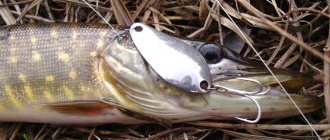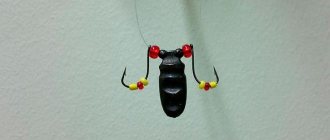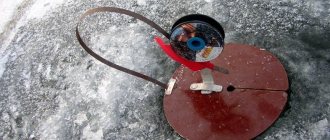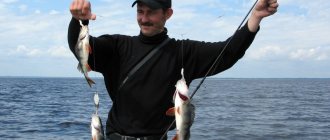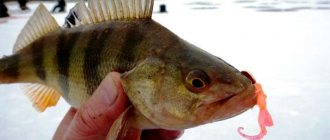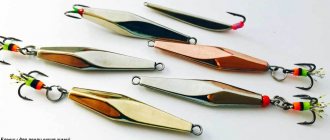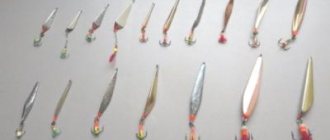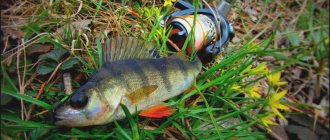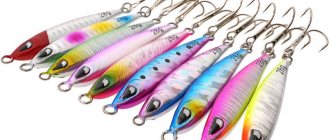Fishing for perch in winter is not a very common and rather narrow direction in fishing.
Most often they are used on larger predatory fish, such as pike or pike perch. Catching a perch on them is more a rarity than a regularity. In winter, perch is usually caught using a jig, a balance beam or a spoon.
This is a common misconception. This type of fishing can be very exciting, exciting and very productive. This has been proven more than once by winter fishing masters. You just need to know a few subtleties. It is possible that it may become your favorite type of winter hunting..
At the same time, many new anglers often have many questions. The topic is narrowly focused, there is little information. Undoubtedly, it has its pros and cons.
Pros and cons of fishing with a zherlitsa
One of the advantages is the speed of fishing. The striped predator sometimes reacts to the bait immediately after the bait sinks to the bottom. Swallows it deep into the stomach. With the right choice of fishing location, bites can come in succession. There is a high chance of catching 4-5 fish from one hole. Their size will not be large. As a rule, a school of perch weighing 300-400g.
But this does not mean that big fish cannot be caught. Just the opposite. The chance of catching a humpback whale weighing more than half a kilogram is just as great.
A perch girder is also irreplaceable under unfavorable conditions. It was a dead winter or there was a sharp change in temperature. Fish activity drops. It does not respond well to artificial baits. Fishing with live bait using a zherlitsa is an ideal option.
Constantly moving and drilling holes in winter is inconvenient and time-consuming. Setting traps for perch is more effective than running fishing.
Another advantage can be considered the excitement during fishing. Taking off from the spot the moment the red flag is raised. Hooking and landing perch is not boring fishing.
The disadvantages of this type of winter fishing for striped predators include immobility. If the bite is not successful, then moving the traps takes a lot of time and effort. The vents are a three-dimensional structure. And you need at least 5-6 of them.
Also, the presence of large predators in a reservoir can significantly interfere. Tackle for perch is not so durable and a large predator can easily ruin it.
Choosing a time and place for catching perch with girders
At the beginning and end of winter, when the fish are most active, fishing for perch on girders brings the best results. But at the same time, other gear - a jig rod and a trolling rod - often brings results no worse, so you can prefer them. But in the dead of winter, when the fish are passive, girders often help out fishermen. They often bring the best catches, and sometimes save them from complete lack of bite.
It’s also useful to read: How to make a winter fishing rod with your own hands
Since perch remains active throughout the winter, you can catch it with ice girders in any reservoir where it is found. But some water areas are better suited for such fishing, while others are worse.
Zherlitsa prove to be especially effective when hunting for large trophy minke whales. They can also be used to catch medium-sized perch. It is not advisable to hunt small fish with such gear. Accordingly, you need to fish where there are large fish.
These can be large rivers and lakes, as well as reservoirs. On small bodies of water, and often on medium ones, there is no point in catching perch in winter using girders.
Large fish tend to stay further from the shore. It is there that you need to catch it with girders. A good option would be fishing on underwater shallows (banks and ridges) with vegetation and shell rocks. Fish are also attracted to holes, edges and snags.
Design of the vents
What exactly are zherlits? It's essentially a trap. In common parlance - live bait.
Based on the installation principle, they can be divided into two types:
- supraglacial
- subglacial
The set of basic structural elements depends on the type.
They are left under the ice for a long time, often overnight. Periodically check for the presence of a catch or the absence of bait. They do not require constant monitoring. They are also called self-traps or postavushki. The simplest type of girders. She has no bite signal.
You can determine whether it was or not only by the winding on the hose. If the line is reeled in, then there was a bite. This fishing is called passive, for the lazy. Sometimes snowfall creates a problem. It's hard to find your live baits. Experienced fishermen make mounds of snow over the holes with stuck sticks or reeds.
The design is simple and uncomplicated. It is quite possible to make it yourself from scrap materials.
Wire (rope), fishing line, pipe (hose), weight, fishing line, hook, bait are attached to the crossbar in strict sequence. The crossbar can be made of wooden beams. The main thing is that it is strong and at least 2.5 times wider than the hole. Wire (rope) is used because it will not break when frozen into the ice. They are easier to remove from under the ice. In this case, the fishing line remains intact.
Above-ice vents have a signaling device in the form of a brightly colored flag. The main thing distinguishes them from those under the ice. Its function is to inform about the beginning of the bite.
As soon as the flag is raised, this is a signal for active action. Run faster, hook, fish! Waiting for this signal adds incredible excitement, courage and sportiness to this type of winter fishing. And if several flags go off at the same time, then there is no time for boredom, the adrenaline goes off scale.
There are no differences in the design of above-ground vents. The basic elements are the same:
- the base of the vent (plastic, wooden or metal disk);
- flag (bite alarm);
- reel with base (reel).
Such models are produced by many manufacturers. The principle of operation is similar for all. The predator grabs the bait. The line stretches and unwinds from the reel. The bright signal rises up and reports a bite. Then everything depends on the reaction speed and skills of the fisherman.
Different ice baits are suitable for different weather conditions.
On the platform - more universal, for any weather and ice cut. They are stable, lightweight, and collapsible. They are usually preferred when purchasing.
On a rail - they take up little space, but are not suitable for bare ice or snow. There is nothing to attach the rail to.
The so-called tripod is less stable and does not protect the hole from snow.
The horizontal one has the same disadvantages.
There are several models of foreign origin. They are equipped with electronic devices for recording the depth and footage of the reeled fishing line. But since operating conditions in the latitudes of America and Russia are different, such models have not found widespread use.
Equipment Features
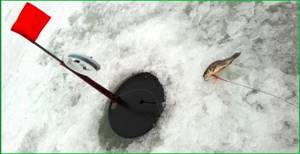
What is a perch girder and how is it different from girders for other fish?
Features begin when choosing equipment. After all, their wrong choice can affect the entire course of fishing.
Perch is a predatory fish, active and boldly attacks bait. But it does not have teeth like the pike. This is what distinguishes traps for perch in winter from the same traps for pike or burbot.
Many novice fishermen play it safe and use a hard lock. When it flies up, it spins the reel strongly. The bait breaks out of the mouth. The most common mistake. A short leash or an unsuitable hook is also unacceptable. This leads to a greater number of empty operations and can discourage all desire to catch perch in the winter with girders.
The equipment needs to be used more delicately. The line is thinner. A thickness of 0.25-0.3 mm will be sufficient. To catch perch on a girder in winter, you don’t need a larger meter of fishing line on the reel. The length to the bottom (+5 m in reserve) is quite enough.
It is advisable to have a leash made of monofilament fishing line or fluorocarbon with a diameter of 0.25 mm. Length 25-30 cm. It is less noticeable to fish and does not wear out much. It should be used in cases where predatory fish are rarely found in the reservoir. Otherwise, the leash is made stronger, to the detriment of the number of bites.
The sinker is light, sliding, and olive-shaped. The choice of weight is affected by depth. The presence of a current or its absence. 15-20 grams is quite suitable for a depth of up to 8 meters. This allows the bait to move freely without being pinned to the bottom.
The hook you choose is a regular one, single with a long shank. Doubles and tees, if desired, are also possible. It depends on what trophy they intend to get.
There are several options for bait bait. The most common one is behind the back, under the fin. You need to be very careful and try not to leave the ridge intact. Live bait must be mobile.
Gear equipment for catching perch in winter
The standard equipment for catching perch in winter is as follows:
- The main line is located on the reel or reel; there is no point in winding it a lot. It is enough that its length is 5 m greater than the depth at the fishing site. It is necessary to use monofilament or fluorocarbon fishing line with a diameter of about 0.2-0.25 mm. Fluorocarbon is preferable because it is least noticeable in the water, and medium- and large-sized perch are quite cautious. The peculiarity of fishing with girders is that the fish can always see the bait before attacking. If a minke whale notices something is wrong, it may become wary. Using a leash doesn't make much sense.
- On the fishing line you need to put a sliding sinker-olive weighing about 6-10 g.
- A hook must be mounted at the end of the line. It is selected according to the size of the bait and the fish that are supposed to be caught. You can use both singles and doubles or tees.
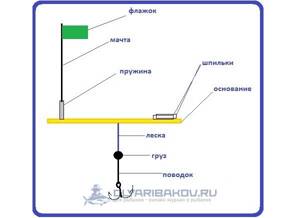
For fishing at great depths in the current, it is better to use special equipment for such situations. To make it, you need to attach a sliding sinker to the fishing line, which will lie on the bottom and hold the installation in place. In this case, several leashes can be used at once.
You will learn how to properly equip and configure your vent from this video:
How to make a zherlitsa with your own hands
Many fishermen like to make their own girders. The simplest fishing rods for perch consist of a wooden fork 30 by 10 cm. Reels, fishing line, weight and hook. There is no protection of the hole from freezing and snow. More suitable for ice fishing methods.
To catch perch on the surface in winter, you can assemble them with your own hands in several ways. The first is the easy way. All components are purchased in the store: a base with a cut to the center, a reel, a flag, a fishing line, a weight, a hook. All items are replaceable and sold separately.
If there is no opportunity or desire to buy, then you can make the main elements yourself. Cut the base from plywood or plastic. The form can be any. The main thing is that the diameter is larger than the hole. For the flag, take a material of a bright color that will be clearly visible from afar. Spring wire 1 mm thick, a bicycle knitting needle or a thin-cut strip of elastic plastic instead of a holder. Its length is from 25 to 40 cm. The reel and base are connected using a regular PVC pipe. Through the holes in the reel, or with electrical tape to the holder on the base. An ordinary plastic pipe with a clip works well as a holder.
Do-it-yourself zherlitsa video
DIY winter girders for perch
You can make a good girder for catching perch from ice with your own hands. This is exactly what many experienced fishermen do, since finding the “right” working gear on sale can be difficult or impossible.
To make a classic girder with a flag, you need to make a base, attach a leg with a coil to it, and then attach the flag to a piece of thin steel plate. Anyone can build such equipment with their own hands.
But there is also an easier to manufacture and cheaper option. Such a vent is made as follows:
- you need to drill holes in the plastic tube and glue two pieces of wire located perpendicular to each other (they will act as legs);
- wrap one end of the tube with bright electrical tape or paint it;
- at the other end of the tube, make a slot in which the fishing line will be fixed after the rig with live bait is lowered to the required depth;
- wrap the line itself around this end of the tube.
Important! In winter, perch, even large ones, often take live bait carefully.
Therefore, it is important that the bite alarm works easily and shows even the most accurate fish attacks on the bait. How to make a zherlitsa with your own hands is clearly shown in this video:
Fishing tactics
To successfully catch perch in winter, both large and small, you need to know their behavioral characteristics at this time and their food preferences.
In winter, periods of perch activity are replaced by passivity. But even in the passive period, the striped predator can be stirred up.
Activity directly depends on the month and weather conditions. At the beginning of winter and at the end of winter, perches like to live in shallow water, close to the shore. Especially in places where there is a sharp change in depth. This is a dynamic time for Pisces. This is the tactic here.
If you are on an unfamiliar body of water, the first thing to do is determine the depth. There are manual methods: marker float, tapping with a weight. An electronic echo sounder is often used. The accuracy of the readings determines the success of fishing. The correct location for drilling holes for traps is the key to success.
Holes are drilled immediately, at least 10. Place from five to seven holes. The distance is approximately 10-15 meters. More is possible, but no more than fifty meters. It is worth moving in the direction from the shore to the depths. It’s good if you have a partner or company. This way the work will go faster.
The bait fish is hooked behind the back of the fin. The distance to the bottom is no more than 50 cm. As soon as the flag is triggered, you should immediately hook, in the first 5 seconds.
What happens during this time? The perch grabs the fish and tries to stun it by shaking its head. This takes literally a couple of seconds. Then he just swallows it. This is the perfect time to strike.
It is done without sudden jerks, with springy movements. The lips of a perch are delicate, you can tear them off and be left without a catch. If you're lucky, it's worth placing a few more girders nearby. Perhaps this is the arrival of the pack.
If there is no bite within half an hour, it is worth moving the first bait forward. And so move further along the water area until it starts to bite. The predator often changes its habitat. Accordingly, the fisherman should not linger in one place.
There are several tricks to attract a school of perch. They are used by skilled fishermen. One of them is imitation of a flock. Three holes for the vents are drilled close to each other in a triangle. No further than half a meter. An artificial school can attract either a lone humpback bass or a small school of perch.
There is an easier way to imitate a flock. Several fry cling to the tee at once. Their fuss may well attract attention.
In the dead of winter, in January, the predator is passive. He changes his place of residence. From shallow water it goes deeper, under snags, closer to the algae. It’s worth catching it point-by-point, feeding the bait literally under your nose. Therefore, the holes are drilled at a close distance from each other in a checkerboard pattern.
The predator took the bait, but got away. It is worth drilling everything around at a distance of 1.5-2 m. Stir it up, perhaps feed it with bloodworms. This is a one fish hunt. Monotonous, but no less exciting.
Important nuances of perch fishing tactics
In winter and summer fishing for predators and various types of whitefish, rigs with several artificial or natural baits are often used, creating the so-called “flock effect”, which often has a positive effect on the bite of capricious, inactive fish. For example, in spinning rods the asp “flock” is popular - at the end of the fishing line there is a castmaster, in front of it there are several artificial flies on short leashes. Or the well-known winter “garland” - equipment with many jigs, which, according to popular opinion, not only quickly catches different layers of water, but also attracts fish precisely by the “schooling” of baits. Or the pike bet often works immediately after playing a little with a balance beam or a vertical spinner in the next hole - a “flock” of artificial-natural origin has worked.
A bunch of worms, bloodworms, maggots on a hook, by and large, is also a kind of “flock”, designed to work according to the principle “the mouth rejoices in many pieces.” Or an unusual technique sometimes practiced by bettors: two live baits are hooked onto a tee at once, baited by the lip, and you get a really miniature school of two fish, usually nimble minnows, which with their fuss are much better at stopping various types of predators compared to a traditional single live bait.
Read: Choosing a suit for winter fishing
When hunting for perch, another trick is practiced: three baitfish are placed in a group, no more than half a meter apart from each other, offering the sluggish humpback a flock of three live bait. This is exactly the technique used by skilled fishermen who are going to catch perch with small fish.
Tactically, jig fishing is diverse. It’s one thing to search widely for perch in large bodies of water, where the location of the fish is initially unclear. And it’s quite another thing to “irritate” a sluggish striped fish when it’s clear where exactly it’s holding, but is in no hurry to peck. This often happens on small lakes and ponds, where perch are found in decent numbers, during periods of changing weather, when the atmospheric pressure is extremely unstable. And then various cunning techniques for “swinging” the holes come to the fore, the live bait “flock” is one of them.
Logic dictates that perch is a schooling predator, and hunts for the same schooling small fish. It is ineffective to chase a single striped fry. This means that it is useful to imitate a flock, albeit a small one. And in a promising place, they usually set up three girders in a triangle, about forty centimeters from each other, with small roach hooked on hooks. It doesn’t make much sense to place the gear wider, a meter or two from each other. It is important that the perch not only record the vibrations of small live bait (they practically do not flutter in icy water), but also see all three from a distance of at least a meter. Otherwise, the whole idea will be ineffective.
Read: Catching burbot in winter using girders
Some questions may arise here, because crowdedly placed rigs threaten to overlap the rigs after the predator pulls, and the live bait themselves can weave a fishing line “beard”, and all three rigs will fail for a long time. But events do not always develop this way. This can happen in pike fishing. There are bigger, faster live baits there. And the pike itself, having swallowed the bait, often goes far and in an unpredictable direction, often unwinding the entire supply of fishing line from the reel. In this case, it can easily overwhelm the equipment of the second girder, installed even at 10-15 m. With perch, events usually develop differently. Live baits are small, they do not have enough strength to swim in wide circles, and at shallow depths, overlaps with neighboring equipment are unlikely; in any case, this does not happen when fishing at depths of up to 2-2.5 m. There are no line overlaps when perch bites. This fish usually unwinds no more than a meter of fishing line and stops. Often there are bites without any unwinding at all - the flag is triggered, the reel is motionless, the striped fish is caught and stands still, sadly waiting for the fisherman.
Bait for fishing on a girder
Zhivey is the best bait for winter fishing with a zherlitsa. It can be any small fish with a narrow body. Live bait - sprat, dace, bleak, bitterling, gudgeon. Mobility is the main requirement for bait. It is a mistake to think that the larger the bait, the larger the catch. This is not suitable for winter fishing for perch. More likely to attract pike if there is one.
You need to prepare bait in advance. It is better to bring it with you in a foam container. While fishing, you can also catch live bait with a jig, if you have time.
Fishing technique
Live bait clings to the back and is placed 20-50 centimeters from the bottom. When triggered alone, the girders move to the bite site. The nature of the grip of a perch is not the same as that of a pike. It has no teeth in its mouth, so the perch does not wait for the prey to calm down. The predator shakes its head to stun and dangle the prey in the water (up to 2-3 seconds), then swallows it. Therefore, you should react quickly to rises. It is advisable to hook already 4-5 seconds after the trigger, otherwise the predator may leave. The perch's lips are quite weak and tear easily, so the hook should not be too sharp, but soft and springy. If a flock is clearly approaching one hole and there are constant bites, it is recommended to switch to active fishing for perch with a live bait rod - it is easier and faster to handle. You can also try to see if the striped fish takes a balancer, a spinner or a jig.
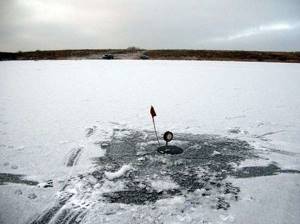
Summarize
If you decide to try catching perch with a girder in winter, then first you should understand the topic in detail and do not rush. Choose the type of fishing - surface or underwater. Study the water area where you are going to fish. Find out if there are predatory fish.
Depending on the result, select equipment. Get an echo sounder. Consider the time of year and weather conditions. Decide on the choice of the girder model. Or maybe try to do it yourself. Buy or catch bait yourself in advance. The result may pleasantly surprise you and leave you with pleasant emotions.
